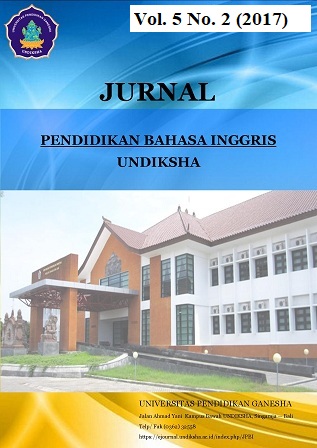A Study of Morphological Processes of Balinese Dialect Spoken by Klumpu Villagers
DOI:
https://doi.org/10.23887/jpbi.v5i2.13328Abstract
Penelitian ini bertujuan untuk mendeskripsikan proses morfologi pada dialek bahasa Bali yang digunakan oleh masyarakat desa Klumpu (BDK) di Nusa Penida, kabupaten Klungkung, provinsi Bali. Penelitian ini merupakan penelitian deskriptif kualitatif. Subjek di penelitian ini adalah pembicara asli dari dialek bahasa Bali di desa Klumpu. Subjek tersebut dibagi menjadi tiga area, yaitu lingkungan keluarga, tetangga, dan pertemanan. Data dikumpulkan dengan melakukan observasi, wawancara, rekaman, dan elisitasi untuk mencapai kejenuhan data. Data yang sudah dikumpulkan kemudian dianalisis dengan menerapkan prosedur analisis data dari Miles dan Huberman (1994). Yang menjadi objek pada penelitian ini adalah proses morofologi itu sendiri yang mana terdiri dari infleksi, derivasi, afiksasi, pengulangan, kliping, blending, komponding, dan back formation. Hasil dari penelitian ini menunjukan bahwa terdapat empat jenis prefiks infleksi: {me-}, {nge-}, {ng-}, {ny-} dan empat jenis sufiks infleksi: {-e}, {-an}, {-in}. Terdapat dua jenis prefiks derivasi: {me-} dan {ny-} dan dua jenis sufiks derivasi: {-te} dan {-an}. Terdapat lima jenis prefiks afiksasi {a-}, {me-}, {pe-}, {ng-}, {ny-}, satu jenis infiks afiksasi {-h-}, dan empat jenis sufiks afiksasi {-an}, {-ang}, {-ne}, dan {-e}. Ditemukan dua jenis reduplikasi yaitu reduplikasi dengan dan tanpa afiks. Terdapat empat jenis kata yang mengalami proses kliping. Ditemukan tiga kelas kata yang mengalami proses blending. Ditemukan pula bahwa terdapat satu kelas kata yang mengalami proses komponding yaitu kelas kata benda. Tidak ditemukannya kata-kata yang mengalami proses back formation dalam BDK. Kata kunci: dialek Klumpu, proses morfologi, infleksi, derivasi, afiksasi, reduplikasi, kliping, blending, kompon, back formasiKata Kunci : afiksasi, back formasi, blending, derivasi, dialek Klumpu, infleksi, kliping, komponding, proses morfologi, reduplikasi.
This study aimed at describing morphological processes of Balinese dialect of Klumpu villagers (BDK) in Nusa Penida, Klungkung regency, Bali province. This research was a qualitative descriptive study. Subjects of this study was the native speakers of the BDK. The subjects were divided into three areas namely family, neighbor, and friendship area. The data were collected by conducting observation, interview, recording, and eliciting technique for saturation. The obtained data were analyzed by using the procedure of data analysis suggested by Miles and Huberman, (1994). The object of this study was morphological processes of BDK that consisted of inflection, derivation, affixation, repetition, clipping, blending, compounding and back formation. The results of this research show that there were four kinds of inflectional prefixes: {me-}, {nge-}, {ng-}, {ny-} and four kinds of inflectional suffixes: {-e}, {-an}, and {-in} in BDK. There were two kinds of derivational prefixes: {me-} and {ny-} and two kinds of derivational suffixes: {-te} and {-an}. There were five kinds of prefixes of affixation: {a-}, {me-}, {pe-}, {ng-}, and {ny-}. One kind of infix of affixation: {-h-} and there were four kinds of suffixes of affixation: {-an}, {-ang}, {-ne}, and {-e}. There were two kinds of reduplication namely reduplication with and without any affixes. There were four kinds of word classes that underwent clipping process. There were three word classes that underwent blending process. There was one word class that underwent compounding process namely nouns. There was no any back formation word found in BDK.
keyword : affixation, back formation, blending, clipping, compounding, derivation, inflection, Klumpu dialect, morphological processes, reduplication
Published
2018-02-20
Issue
Section
Articles
License
Authors who publish with the Jurnal Pendidikan Bahasa Inggris Undiksha agree to the following terms:- Authors retain copyright and grant the journal the right of first publication with the work simultaneously licensed under a Creative Commons Attribution License (CC BY-SA 4.0) that allows others to share the work with an acknowledgment of the work's authorship and initial publication in this journal
- Authors are able to enter into separate, additional contractual arrangements for the non-exclusive distribution of the journal's published version of the work (e.g., post it to an institutional repository or publish it in a book), with an acknowledgment of its initial publication in this journal.
- Authors are permitted and encouraged to post their work online (e.g., in institutional repositories or on their website) prior to and during the submission process, as it can lead to productive exchanges, as well as earlier and greater citation of published work. (See The Effect of Open Access)













